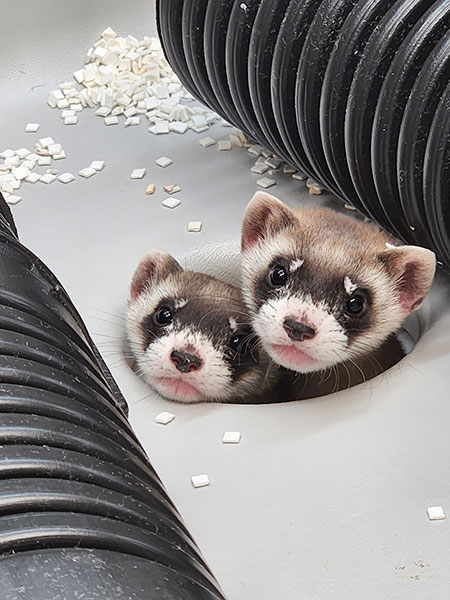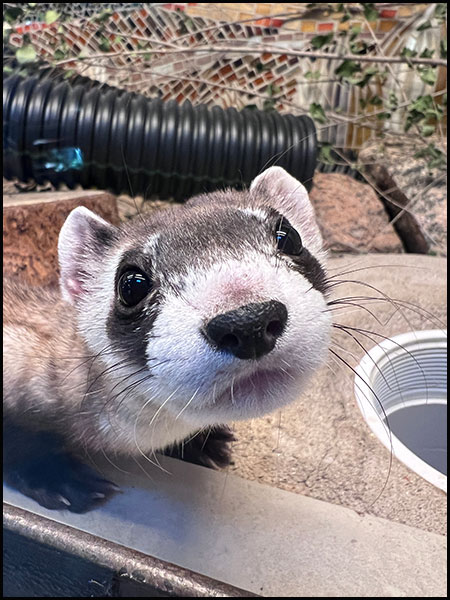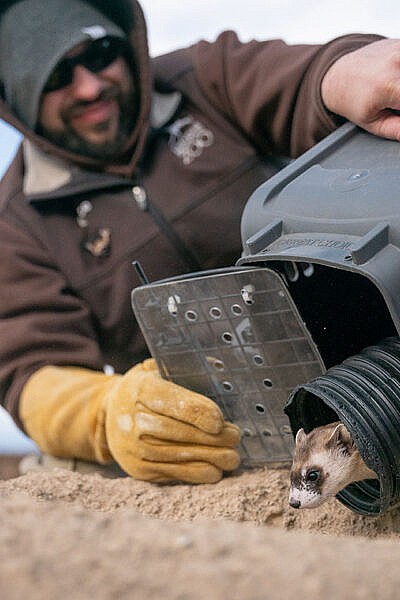This summer, the black-footed ferret (BFF) breeding program at Cheyenne Mountain Zoo saw a record number of kits born: 37. Conservationists tested multi-partner breeding to see if females could conceive and whelp kits from different dads in the same litter, and to see if having multiple breeding partners impacted the number of kits born overall.

Out of seven females in the trial, two had litters with two fathers represented. Of the twelve breeding females in the CMZoo program, eight had babies this year.
“That’s a really high rate of reproduction, and we saw a higher rate of successful birth with the females that participated in the multi-male study, compared to those that didn’t,” says Jeff Baughman, Wyoming Toad and Black-Footed Ferret Program Manager at CMZoo. “We’re not getting ahead of ourselves, but the results are promising because there’s potential to increase the genetic diversity and sheer number of kits one female could contribute to the recovery population.”
BFFs have incredibly few breeding opportunities. Females are only typically reproductive from 1 to 4 years old, and they only breed once per year – during a 72-hour window. In human care in the past, females spent all three breeding days with the same male. In this trial, they spent the first 24 hours with one male, the second day with another, and the final 24 hours with a third male.
Because female BFFs are induced ovulators, the act of breeding with the first male could trigger ovulation that could possibly make the second and third males’ breeding more successful. However, some females successfully bred and conceived with their first partners, according to the genetic testing.
“It’s always good to replicate a study to see if you can recreate the same results,” Jeff says. “We’d want to use the same trial methods with different breeding females, and we’d want to compare several seasons’ results before we made any official recommendation for or against multi-partner breeding. For now, this is exciting because it’s the first time we can prove that female black-footed ferrets in human care can successfully conceive and whelp kits with different fathers in the same litter.”
BFFs were considered extinct until the 1980s. On Sept. 26, 1981, a ranch dog named Shep caught a BFF. Shep’s catch led to the discovery of a small population of the elusive animals in Meeteetse, Wyoming. That population became the hope for the recovery of the entire species.
Since then, zoos, U.S. Fish and Wildlife, National Black-footed Ferret Conservation Center and other organizations have banded together to breed, prepare, release and monitor BFFs to increase the population. CMZoo joined the fight to save ferrets in 1991, when its BFF breed-and-release program began. In the last 33 years, 647 kits have been born on Cheyenne Mountain. The Zoo is a major contributor to recovery efforts, releasing BFFs to protected wild places in Colorado every year.

Some of the kits with the most underrepresented genes in the breeding population will stay in human care, as part of the breeding program, so they can pass on their underrepresented genes to another generation. Others go to boot camp, to see if they have the skills to thrive the wild. In mid-September, all surviving CMZoo kits and four adults (two of which are mothers, going to ‘boot camp’ with their kits) will start their 35-day pre-conditioning journey in a semi-wild environment at the National Black-footed Ferret Conservation Center in Fort Collins, Colo.
Of those, some are released and some – who do not prove they can hunt, seek shelter and protect themselves in the wild – return to human care, to serve their species in breeding programs or as ambassadors in zoos and other educational settings.
Samosa is the newest black-footed ferret ambassador in The Loft, where guests have a rare opportunity to see this native and critically endangered species up-close at our Zoo.
“Samosa is a great representative of the species,” Jeff says. “She’s energetic and bold, but unfortunately dental issues prevent her from hunting successfully in the wild. As she’s past breeding age, she won’t participate in the breed-and-release program, so we’ll take care of her in The Loft for her remaining natural years.”
Sept. 26, the date Shep discovered the foundational BFF population in Wyoming, was later named Black-Footed Ferret Rediscovery Day – a day BFF advocates celebrate annually. At CMZoo, guests can meet Samosa in The Loft and participate in a variety of activities from 10 a.m. to 4 p.m. on Sat., Sept. 28 and Sun., Sept. 29, 2024.
Black-Footed Ferret Rediscovery Day details:
Sat., Sept. 28 and Sun., Sept. 29, 2024
10 a.m. to 4 p.m.
Stations will be set up in Scutes Family Gallery, in My Big Backyard near the Tree House and outside The Loft. Activities will include:
- Coloring stations – make a black-footed ferret mask and color a prairie scene
- Prairie Jenga – learn how the prairie ecosystems depends on all its residents to thrive
- Matching game – match cards representing different elements of the prairie
- Board game – learn about the black-footed ferret life cycle
- Scavenger hunt – locate prairie species
- Keeper talk – enjoy a black-footed ferret keeper talk at 11:30 a.m. in The Loft
Advance daytime admission tickets are required, and all BFF Rediscovery Day activities are included with admission. CMZoo memberships and admission directly support black-footed ferrets through the Zoo’s Quarters for Conservation program, which, since 2008, has raised $5 million for frontline conservation efforts, including breeding and releasing BFFs.

